If you like this tutorial on How to Make Buttermilk Biscuits, visit our Bread Recipes page for more fantastic homemade breads.
There are times when nothing but a biscuit will do. Drop biscuits are okay; they can fill in the gaps when you are desperate and short on time.
But most of the time, what I’m really and truly hankering for is a lofty, perfect, flaky, layered-from-top-to-bottom, golden brown, moist, golden brown, and delicious buttermilk biscuit. I’m talking about the kind where you can split it in half with your fingers and slather with cold butter and strawberry jam or cover with sausage gravy.
My homemade buttermilk biscuits were always really good… My grandma’s from Arkansas, folks, and she’s an amazing cook and it was her recipe I always made.
Then I learned a few techniques after attending a King Arthur Flour traveling baking demo (and later their Blog & Bake event), that turned my biscuits into the most perfect flaky layered buttermilk biscuits. My Perfect Flaky Layered Buttermilk Biscuits are now the One Biscuit to Rule Them All.
What are these magical techniques? I’ll summarize first.
If these sound fussy, I’ll explain why they make a difference further up and further in! (Name that reference!)
How to Make Buttermilk Biscuits
- Use COLD butter. Do not soften it at room temperature at all.
- Cut your butter into both pats and cubes before working them into the flour.
- Use your hands to work in the butter. Don’t use knives, forks, a pastry cutter, or a food processor.
- Don’t add too much buttermilk. It’s easier to add more later than it is to take excess out.
- Be gentle!!! Don’t overwork or manhandle the dough. Stay relaxed. Biscuits are happy food!
- Use a sharp biscuit cutter. Don’t use a jar, juice glass, or tea cup unless the edge is sharp enough to hurt your lip when you drink from it.
- Push straight down when cutting biscuits. Don’t spin or twist the cutter. Straight down and straight back up!
- Get as many biscuits out of the first cutting as you can. Each subsequent re-rolling and cutting of the dough yields tougher and tougher biscuits.
- Don’t crowd the pan. Make sure each biscuit has room to grow!
Those are the rules. Now, let’s break this down a little more…
Homemade Buttermilk Biscuits
I am not kidding you when I tell you one of the main keys to perfect biscuits is cutting your butter two different ways. When you read through the recipe, it will be obvious that the photos show a double batch here. Because BISCUITS!
Notice that I cut half of the SUPER COLD butter into super thin pats and half into long quarters (or batons) and then crosswise into cubes. There is a scientific reason to this.
You don’t want homogenous pockets or ‘chunks’ of butter in your biscuit dough. Smaller pieces yield tender dough, larger, flatter pieces yield flakiness.
Both of those traits are prized in biscuits. Starting with the butter in two different shapes and sizes helps yield that desired final product.
Using cold butter is crucial, too. Cold butter melts when it’s in the hot oven rather than when it’s being worked into the flour.
The longer it takes to melt, the better… That helps create the layers, too, in our perfect Homemade Buttermilk Biscuits.
Because this recipe uses self-rising flour, you don’t have to worry about anything other than measuring said flour into a nice, large mixing bowl. Into the flour goes the butter.
Now, drop your finger tips into the flour and butter and pull apart the butter pieces while tossing them into the flour. Don’t use the palms of your hands because those radiate heat and that melts butter which makes tough biscuits.
TOUGH BISCUITS. It sounds like an insult, doesn’t it?
Here’s a little video my 13 year old helped me make to show you what I mean years ago. Please enjoy the squawking in the background.
This is a real home with real children who eat the real food I share. They’re especially fond of biscuits.
This brings me to an important point.
Why should I use my hands to work the butter into my homemade buttermilk biscuit dough?
There’s a simple reason for this; it’s because you literally get a feel for how the dough is behaving.
When your hands are in the dough, you know when there are pieces that are too big. You also know when it will or won’t hold together, and you know you’re not beating the tar out of it which would yield TOUGH BISCUITS.
And I’m also not kidding when I tell you that your dough will look a little shaggy -okay, a lot shaggy- when you turn it out of the bowl. In fact, if you’ve not had success with biscuits before, you’re quite likely to think you’ve gone dreadfully wrong and that I’m crazy.
You’re going to be tempted to add a lot more buttermilk, but resist! Don’t do it! Trust me!
It’s time to pat out and fold the dough. That’s how we get all the lovely layers.
Here’s the method:
Slide both hands under one side of the dough (at about 9 o’clock if you think of the dough as a clock face), lift it up, and fold it over the other side at 3 o’clock like you’re closing a book. Again, pat the dough round out into a 2-inch thick rectangle.
This time, slide your hands under the bottom of the dough at 6 o’clock and fold it up toward 12 o’clock. Repeat the patting into a 2-inch rectangle, folding from 9 o’clock to 3 o’clock, patting, then folding from 6 o’clock to 12 o’clock.
Each time you do this, the dough should hold together just a little better. Onto rolling the dough!
Just like every other step, use a light hand when rolling the dough. It shouldn’t take much effort to roll it out.
You have a couple of options for cutting the biscuits. You can either use a nice, sharp, open topped biscuit cutter or a knife.
Either way, you will push the cutter or knife straight down toward the counter. Do not twist the cutter or saw the knife back and forth because that will mar the layers you worked so hard to achieve and keep the biscuits from rising high.
Make sure you don’t crowd your biscuits on the pan. They won’t have a chance to rise and have those gorgeous layered sides if you do. With so many do’s and don’ts in this recipe, I’m happy to say I have an optional step for you.
If you’d like them to be a pretty, glossy brown on top, you can brush them with more buttermilk (as I always do). If you prefer a rustic, flour dusted look to the top of your Perfect Flaky Layered Buttermilk Biscuits, omit that step. It’s just a matter of personal preference.
Finally, I have to tell you… this makes a lot of Perfect Flaky Layered Buttermilk Biscuits. It does.
It even makes more than our Viking horde should eat in one meal. (That’s not to say we haven’t eaten the whole shooting match at once, but I recognize that’s a little excessive.)
When I’m feeling virtuous, I freeze half of the unbaked batch for later meals. Sometimes, when I’m really on the ball, I just whip up a batch of dough, cut out the biscuits, and freeze all of them.
Are you wondering whether they’re as good when they’re baked after having been frozen? I don’t blame you if you are.
I offer proof. The Homemade Buttermilk Biscuit on the left was made from fresh biscuit dough.
The biscuit on the right was from pre-cut biscuits that were frozen for a week prior to baking. Both are fanastic, moist, flaky, and layered top to bottom with fabulous biscuit goodness.
Would you like to know something I’ve discovered? The frozen ones, in my experience, puff up a little higher than the fresh ones.
I love having frozen biscuits in the oven for busy nights or unexpected dinner guests. Now, anyone want a Homemade Buttermilk Biscuit?
Cook’s Notes
- There is going to be a little give and take on yield, but if you use a 2-inch round cutter, you should get about 24 Homemade Buttermilk Biscuits from this recipe.
- Feel free to cut them into squares if you’d like to reduce the work and waste!
- This is a case where you really want to use real cultured buttermilk. There are a lot of times when ye olde vinegar-mixed-with-milk substitute will work, but this is not one of them.
Use These to make Buttermilk Biscuits
Connect with Foodie with Family
facebook | pinterest | instagram | twitter
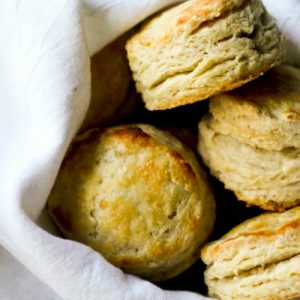
How to Make Buttermilk Biscuits
Rate RecipeIngredients
- 4 cups self-rising flour 1 pound by weight
- 1/2 cup very cold butter 1 stick or 4 ounces by weight
- 1 1/3 cups buttermilk plus extra if needed and for brushing
- all purpose flour for dusting the work surface
Instructions
- Preheat oven to 425°F. Add the self-rising flour to a large mixing bowl.
- Cut the stick of butter in half. Cut one half in 4 batons lengthwise, then cut across the batons to create small cubes. Cut the other half of the butter into pats as thin as you possibly can. Toss the cubes and pats of butter into the flour using just your fingertips so that they are fully coated with flour. Then, one piece at a time, quickly rub each pat and cube of butter between your fingers like you are rubbing dried glue off of your fingers. Continue doing this until all the butter has been rubbed into uneven pieces no larger than peas.
- Pour all but about 2 tablespoons of the buttermilk around the inside edges of the bowl. Reserve the buttermilk in case it's needed. Use a sturdy spoon, silicone or rubber spatula, or flexible dough/bench scraper to toss the buttermilk into the butter and flour mixture until a scrappy dough starts to form. If the mixture is still very dry, toss in the remaining buttermilk. Pick up a small amount of the dough and squeeze it in your hand. If it holds together you're ready to proceed. If most of the mixture is still very dry, you can add buttermilk -1 tablespoon at a time- until the dough holds together when squeezed.
- Dust a clean work surface with all-purpose flour (NOT self-rising here) and scrape the dough out into a pile. Quickly and gently use just enough pressure to pat the pile of dough into a rectangle that is about 2-inches thick. As you're patting it out, gently incorporate any crumbling edges back into the dough mass.
- Slide both hands under one side of the dough (at about 9 o'clock if you think of the dough as a clock face), lift it up, and fold it over the other side at 3 o'clock like you're closing a book. Again, pat the dough round out into a 2-inch thick rectangle. This time, slide your hands under the bottom of the dough at 6 o'clock and fold it up toward 12 o'clock. Repeat the patting into a 2-inch rectangle, folding from 9 o'clock to 3 o'clock, patting, then folding from 6 o'clock to 12 o'clock. Each time you do this, the dough should hold together just a little better.
- Rub a rolling pin with flour and very gently roll out the dough into any shape you'd like, but aim for 3/4-inch to 1-inch thickness. Flour a sharp round or square open-topped biscuit or cookie cutter. Cut straight down into the biscuit dough, not turning or spinning the cutter as you cut. Cut the biscuits as closely together as you possibly can, minimizing any excess between them. If you do not have a sharp biscuit cutter, use a sharp knife and cut straight down into the dough forming squares.
To Bake Right Away:
- Transfer the biscuits to a greased or parchment lined cookie sheet, brush the tops of the biscuits with buttermilk. Put the tray in the oven and bake for 8-12 minutes, rotating the pan front to back halfway through baking. When they are golden brown, delicious looking, and lofty. Remove them from the oven. Let stand at least 2 minutes before eating or transferring to a towel lined bowl.
To Freeze Biscuits for Later:
- Transfer the unbaked, cut biscuits to a parchment lined cookie sheet. Cover lightly with plastic wrap and stick the cookie sheet in the freezer. When the biscuits are frozen solid, stack them in a resealable freezer bag, label the bag, and keep frozen until needed, or for up to 3 months. If you store them longer than that, they will still be bake-able after that, but not quite as high-rising and tasty!
To Bake the Frozen Biscuits:
- Preheat the oven to 475°F. Line a cookie sheet with parchment paper. Arrange the frozen biscuits on the sheet leaving at least 2 inches between each biscuit. Brush the biscuit tops with buttermilk and bake the biscuits for 5 minutes. After 5 minutes, lower the heat to 425°F and continue cooking for 10 minutes or until the biscuits are golden brown, delicious looking, and lofty! Remove them from the oven and let stand at least 2 minutes before eating or transferring to a towel lined bowl.
Nutrition
Nutritional information is an estimate and provided to you as a courtesy. You should calculate the nutritional information with the actual ingredients used in your recipe using your preferred nutrition calculator.
did you make this recipe?
Make sure to tag @foodiewithfam on Instagram and #hashtag it #foodiewithfamily so I can check it out!
Are you looking for more delicious options to fill your freezer and pair with your Buttermilk Biscuits? Try this!
Turkey Breakfast Sausage comes together in a flash and is easily stored in the freezer using a clever method that lets you pull single patties from the bulk package!
You can also ladle copious amounts of this terrific Classic Sausage Gravy over the Perfect Flaky Layered Buttermilk Biscuits and be a very happy human indeed!
This post originally published on October 26th, 2013, updated notes in November 2015, July 2017, and March 2021.
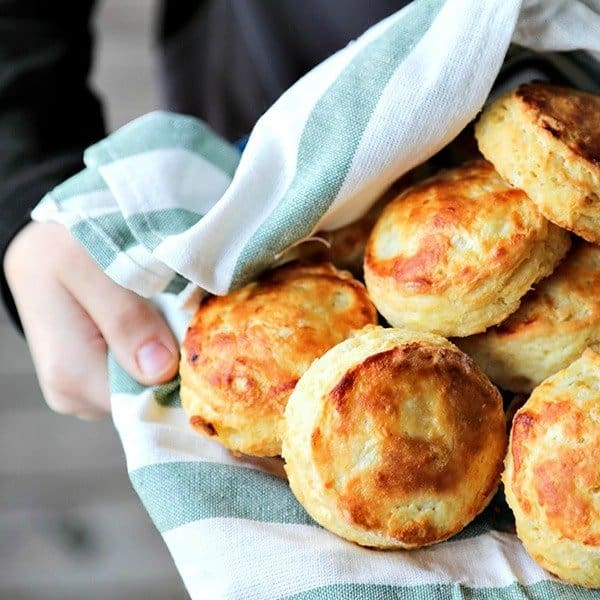
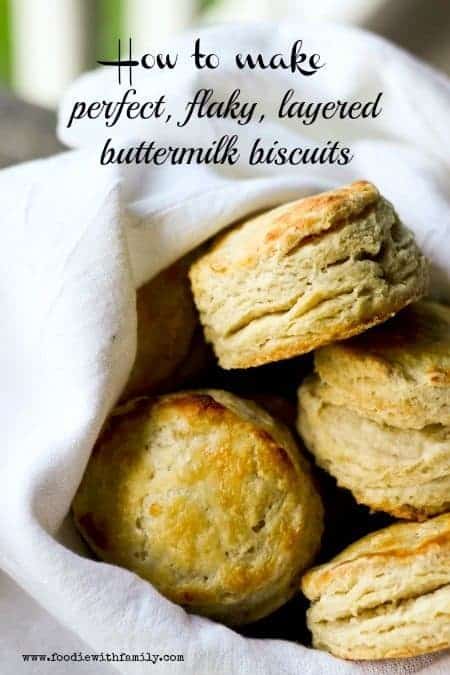
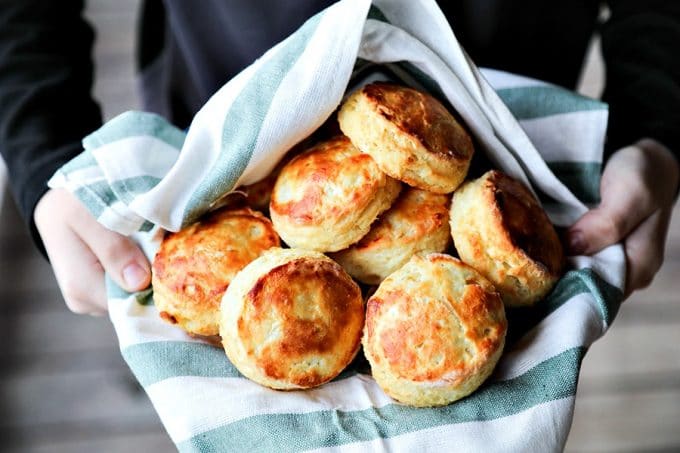
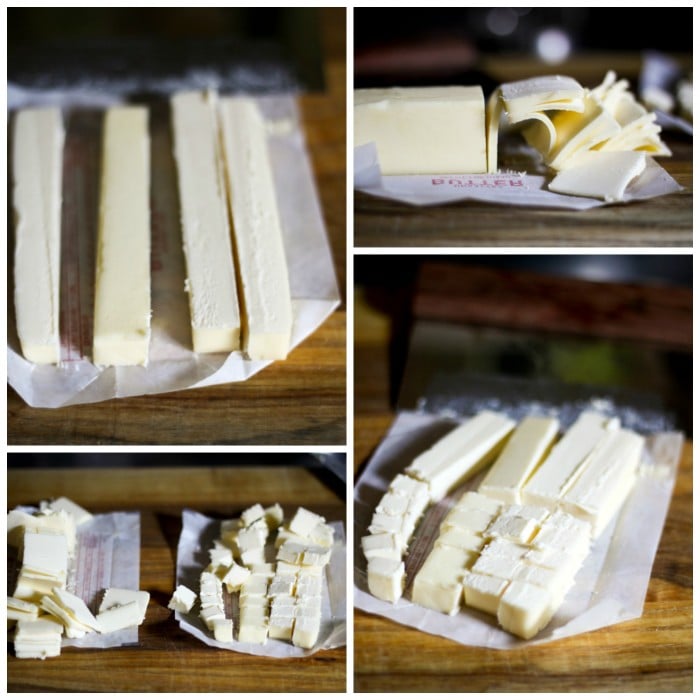
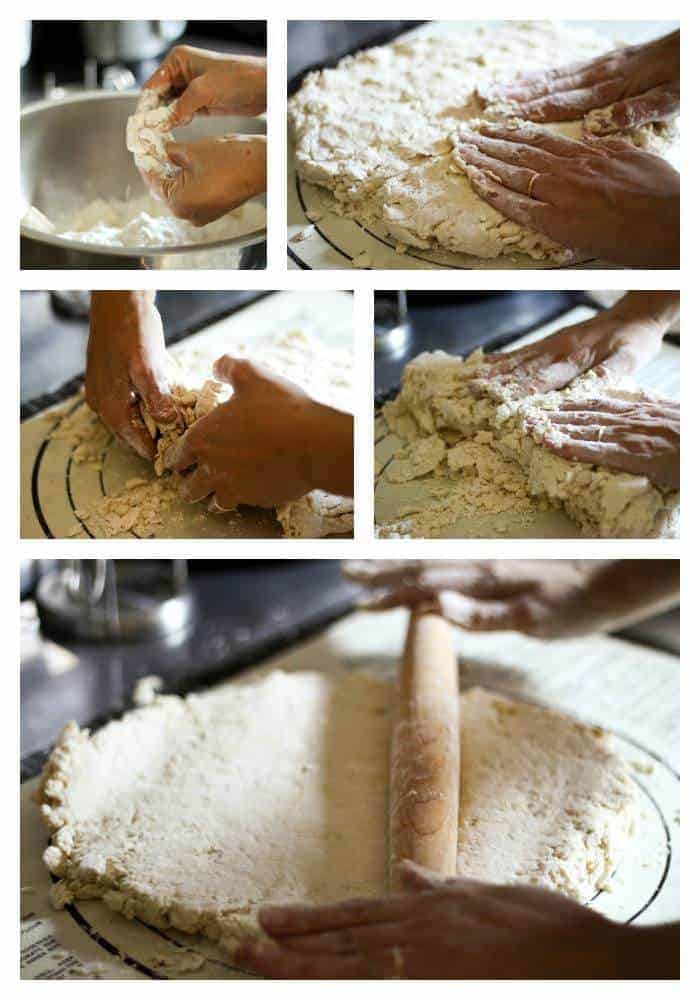
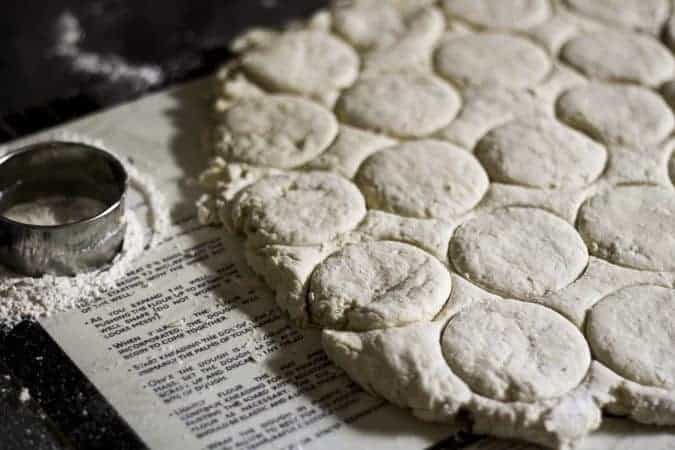
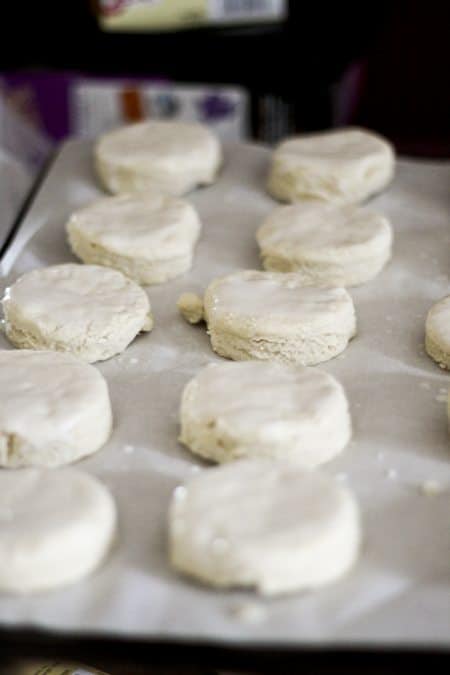
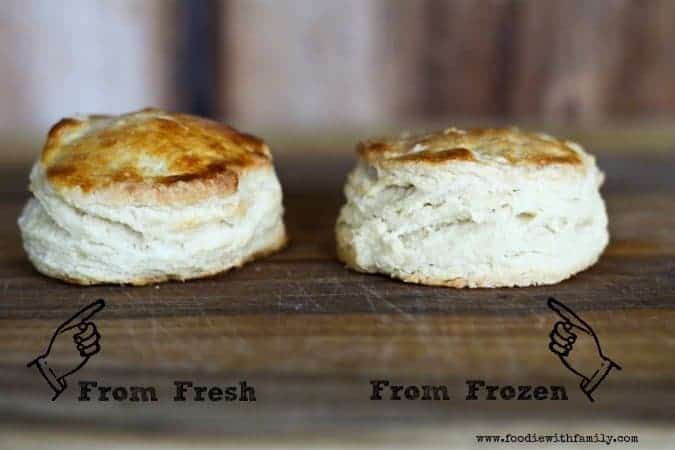
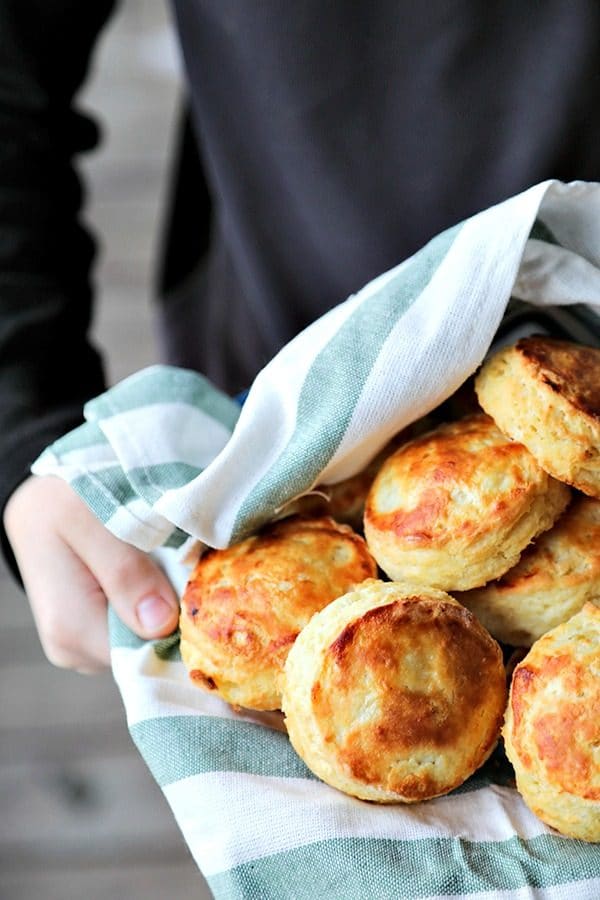

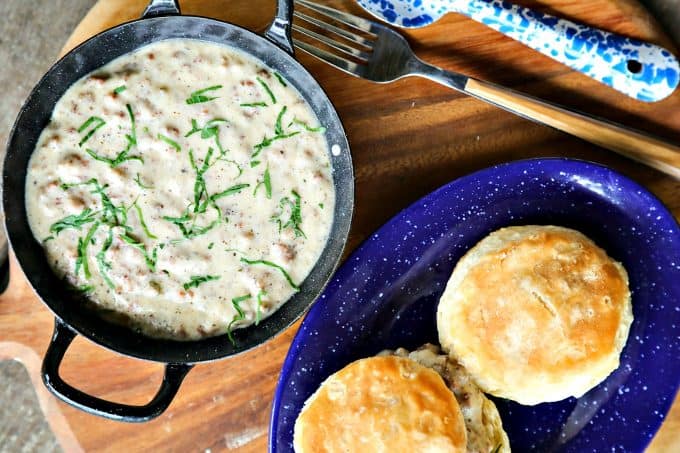
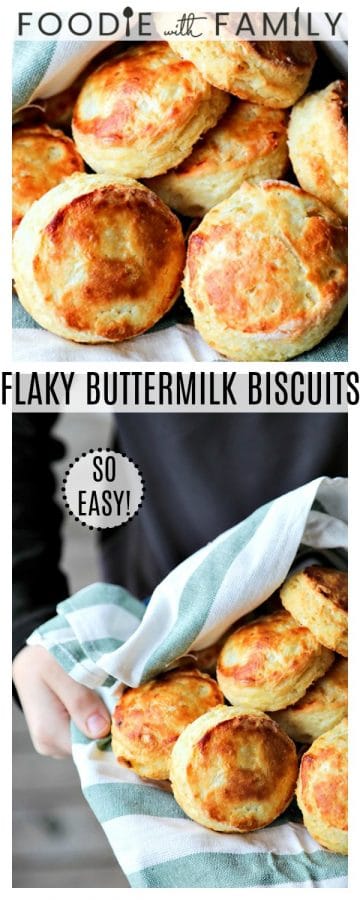



Reader's Thoughts...
Daina says
I’m going to make these, soon. But, may I just say how much I appreciate the video tips? Pics are also great, but seeing what the results should look in real time is really helpful.
Daina says
You said this recipe make alot. How many is alot?
Ted says
I want to make these the night before I bake them. Freezing them seems a waste of time. Can I refrigerate the biscuit and the bake the next morning?
Rebecca says
I’d say just freeze them overnight. Refrigerating won’t stop the leavening from going poof, freezing will 🙂
Sandy says
Have you tried making the biscuits and putting in refrigerator overnight & bake the next morning. I need to have biscuits ready for 15 at 5 am.
Rebecca says
I haven’t, but I have baked them from frozen!
Audrey says
Hi Rebecca! So glad I found your tutorial! I’m hosting a brunch this Sunday for our family and thinking about making them today and freezing them until Sunday. Before I found your tutorial my plan was to make cheddar buttermilk biscuits, do you have any thoughts on using your recipe and adding quality sharp cheddar cheese? (How much to add, bad idea or any recommendations?!) would love your thoughts. Thanks!
Audrey
Rebecca says
Hi Audrey! I’d say play a little with it before the big event! I don’t know how cheesy you want the finished product, so I don’t have a guess to hazard as to how much, but I can say you should toss the cheese into the mix after the butter has been cut in and before the buttermilk has been added! Let me know how it all goes for you!
Audrey says
WOW! Let me just start by saying they are delish!!! I wish I could post a picture on here because they look amazing too!! I added about 1 1/2 cups of extra sharp cheddar in and I think it is perfect. Not too much where it overwhelms but definitely gives a nice cheddar taste. Thank you for all your little steps that I can now see make such a difference. I can’t wait to serve these. And now that I found your blog I will be sure to be back for more recipes! Thanks again, Rebecca!
Rebecca says
WOW! That’s so wonderful! Thanks so much for getting back and letting me know what you did and how it turned out. Hooray!
Melissa @ Bless this Mess says
These are SUPER! I think I might try adding a bit of sugar next go though… I love mine a little sweet. My buttermilk was really old though and extra sour, so that may have given them a lot of extra tang. Can’t wait to make them again!
Paula Engle says
I happened upon this site & literally have biscuits in the oven! They’re looking marvelous! Mine NEVER turn out light & fluffy but these look promising!
Rebecca says
I can’t wait to hear how you liked them, Paula!
Paula Engle says
Delicious! We just had hearty bowls of potato/ham soup that I made this morning with the biscuits. Talk about a wonderful winter’s night meal! My husband is very happy! 🙂
Rebecca says
Oh good! Thank you so much for checking back in with me to let me know it turned out great for you!
Darcy says
Thank you for the frozen instructions. I hope to make this recipe soon and freeze half.
jen says
I can’t wait to try these! I do have one question though; I use regular flour (not self rising) do you know what the measurements of flour and baking powder would be? Thanks in advance!!
jen
Rebecca says
I don’t know it off of the top of my head, but I’m absolutely certain Google can provide the answer! Or KingArthurFlour.com!
Sharisse says
Per cup of all purpose flour add:
1 tsp salt
1 1/2 tsp baking powder
Debi says
I just knew when I was putting in the salt that it seemed like a lot. And it was!!
It should be 1/4 teaspoon per one cup of flour
Amy says
Just curious — when you freeze these before baking, do you freeze them before cutting into rounds or after? Thanks so much for the amazing recipe!
Rebecca says
You freeze them after cutting them. That way you can take out only as many as you’d like to bake. 😀
Lisa C says
Absolutely the best biscuits I have ever made! Great
tutorial! My future daughter in law said “this recipe is a
keeper”
Rebecca says
Thank you both so much!! I am so glad you like them as much as we do!
Rebecca hudson says
Using a frozen stick of butter I grate it into the bowl of dry ingredients then gently toss and work in. I always pat my dough out then cut each one per your method. I do bake in a cast iron skillet like on the old chuck wagons.
Debbie says
How cool is that. I never would have dreamed of grating frozen butter! Wonderful idea.
Peter says
“The Last Battle” (the reference, that is)
Rebecca says
You got it, Peter!
Katrina @ Warm Vanilla Sugar says
These definitely do look perfect!! LOVE!
David @ Spiced says
This looks incredible…thanks so much for posting this how-to!!
Tieghan says
These just got added to my Thanksgiving menu! First Item on there!! Such a great tutorial. I never knew half this stuff, so am I pretty excited to give them a try! 🙂
MaryAnne W. says
I made buttermilk biscuits just this morning (served with REAL country ham, bought from down south) and I make them almost exactly as you…except I did not do the layering technique – must try. I also bake mine in a cast iron skillet that has been heated in the oven and lightly coated with bacon grease. Oh yeah, baby.
I did not know that I could freeze the unbaked biscuits but I am SO going to try it!
Audra | The Baker Chick says
Great tutorial friend! This is one to keep around.. 🙂
Chris says
You just made our week. Forwarded to Alexis because we just said we need to do this. I have a bunch of extra buttermilk leftover (had bought tons to brine wild game) and we wanted to make a counter full of biscuits. Thanks!!
Joanne @ Fifteen Spatulas says
This is a pretty awesome tutorial, Rebecca. Bravo!